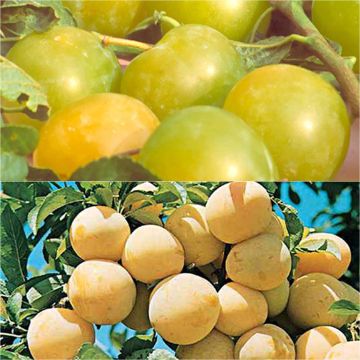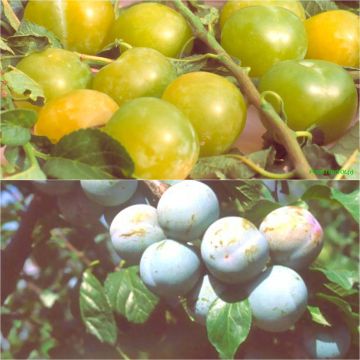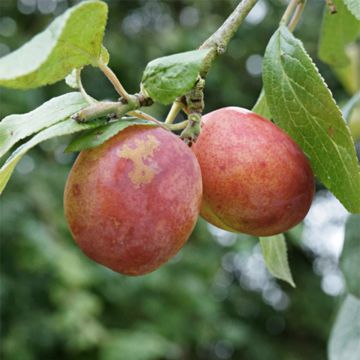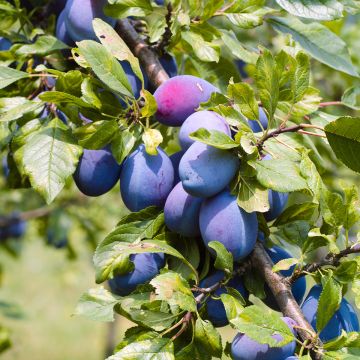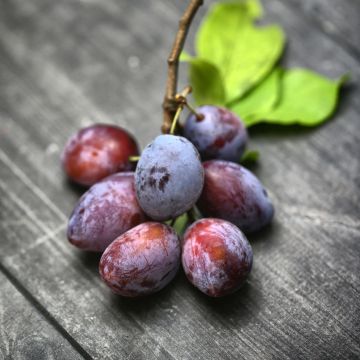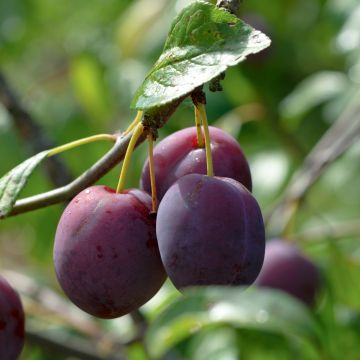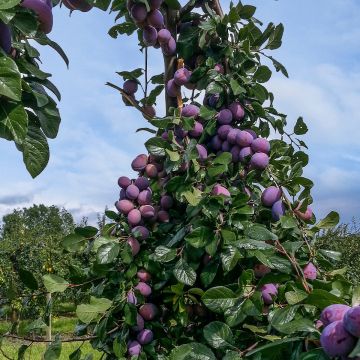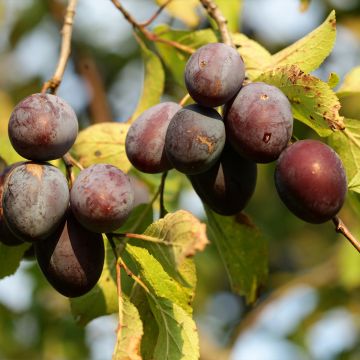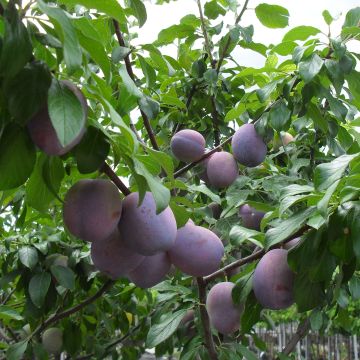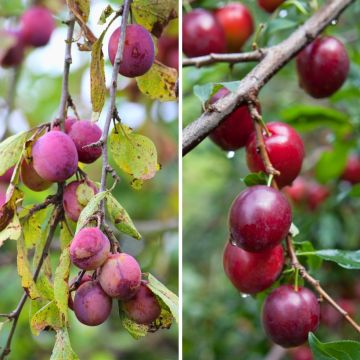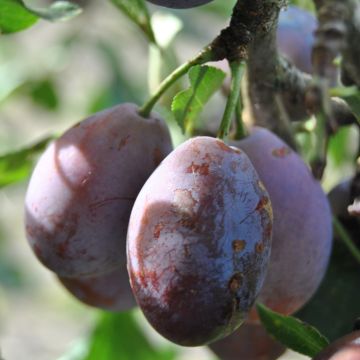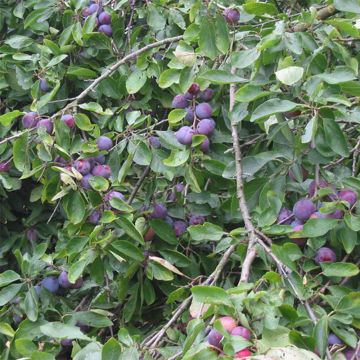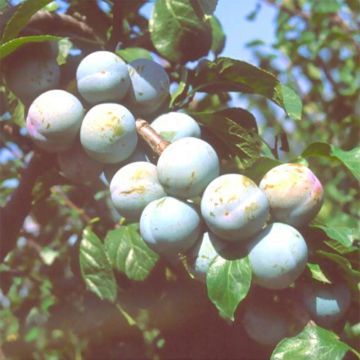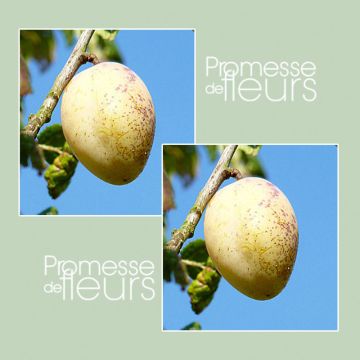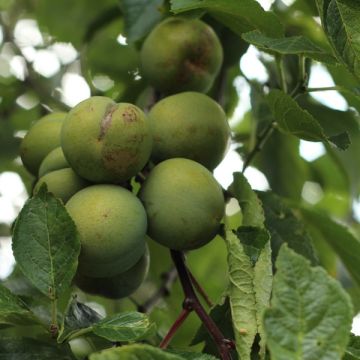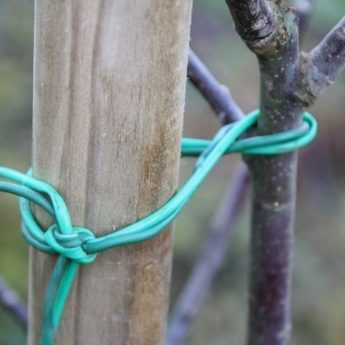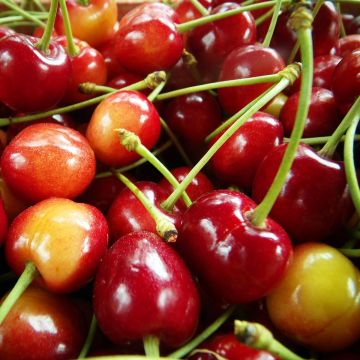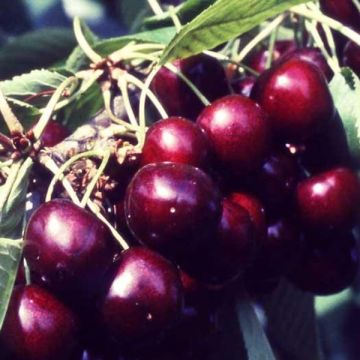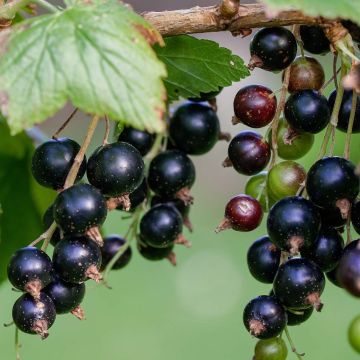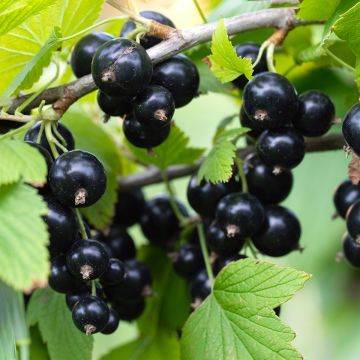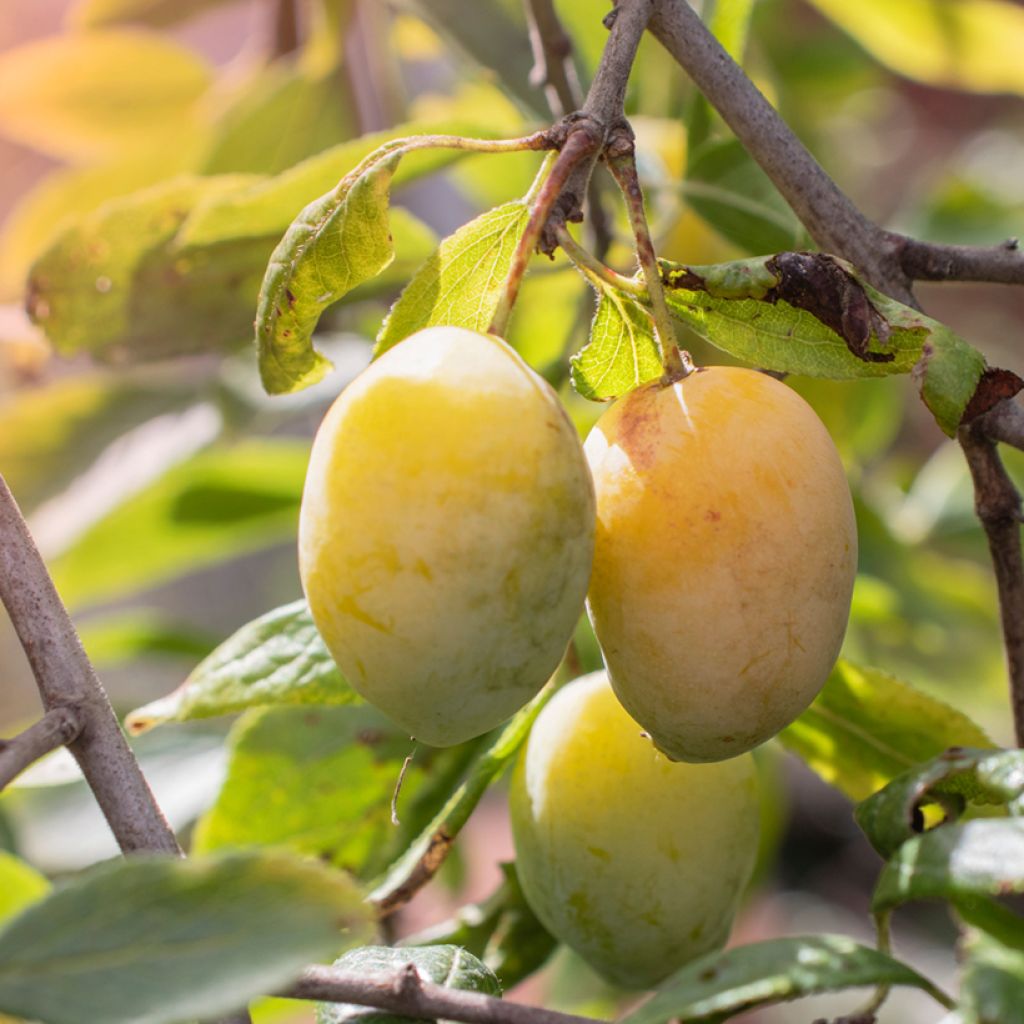

Prunier Quetsche blanche de Létricourt
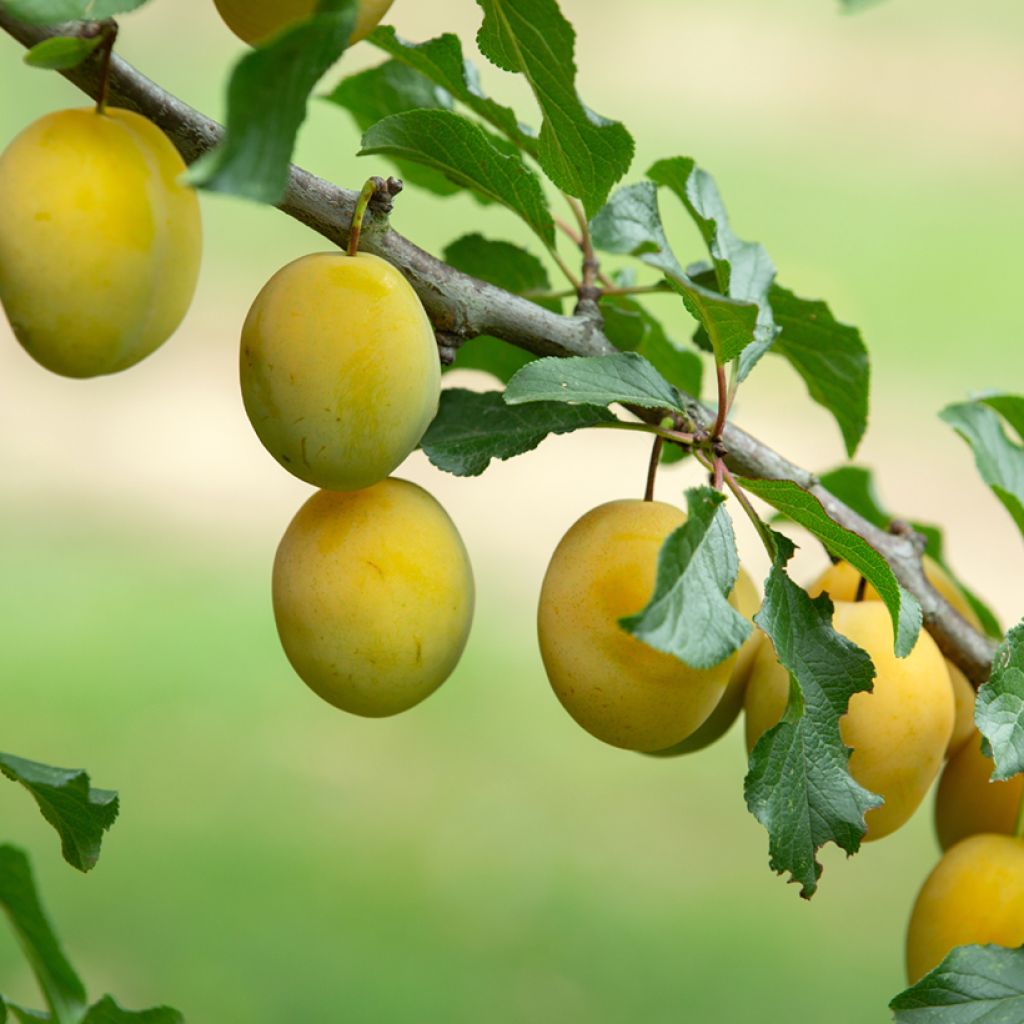

Prunier Quetsche blanche de Létricourt
Prunus domestica Quetsche Blanche de Létricourt - Organic Common plum
Prunus domestica Quetsche Blanche de Létricourt
European plum, Common plum, Garden plum
Why not try an alternative variety in stock?
View all →This plant carries a 6 months recovery warranty
More information
We guarantee the quality of our plants for a full growing cycle, and will replace at our expense any plant that fails to recover under normal climatic and planting conditions.
Description
The Quetsche Blanche de Létricourt Plum Tree is a productive, self-fertile variety that pollinates well, as its flowers are self-pollinating. It produces a large, elongated oval fruit with smooth and chalky, pale yellow to off-white skin. Its yellowish flesh is firm, slightly crisp, sweet and delicately acidic. The stone easily detaches from the pulp. The plum is enjoyable to eat fresh from the tree. When cooked, it lends itself well to many sweet or savoury recipes. It is a fruit with exceptional nutritional qualities. This plum tree is sensitive to spring frosts and prefers a warm, sunny and sheltered exposure. It thrives in ordinary, well-draining, moist, deep and rich soil, not too chalky and without stagnant moisture.
Prunus domestica (Common Plum) is a fruit tree belonging to the Rosaceae family, just like the apricot tree, almond tree and peach tree. It is native to Syria, where it sometimes grows up to 1000 metres (3281 feet) in altitude. The word "quetsche" comes from the German name "Zwetsche", which is itself derived from the Greek "damaskênon", meaning "Damascus plum". Traditionally grown in France, Germany and Austria, the quetsche finds its ideal environment in Alsace, France. The Quetsche Blanche de Létricourt variety has somewhat unknown origins. Some believe it was discovered, before 1882, in Létricourt, a locality in Meurthe-et-Moselle, by Mr. Alix (an arborist in Nancy).
The Quetsche Blanche de Létricourt Plum Tree forms a fruit tree with a fairly rounded framework that can reach a final height of about 4 to 6 metres (13 to 20 feet), producing numerous branches grouped in spreading crowns. Its habit is well suited to free forms on high, half or low stems. Its deciduous foliage is composed of dark green, obovate, 5 to 7 cm (2 to 3in) long leaves with crenate and toothed edges, slightly hairy underneath. Towards the end of March or beginning of April, the white, 1.5 to 2.5 cm (1in) diameter, solitarily flowers appear, before the leaves, on the previous year's branches. The flowering is sensitive to spring frosts, but it is so abundant that frost rarely affects the harvest. It has a remarkably decorative blossom in spring, particularly nectar-rich. It is a hardy tree, tolerating temperatures down to -20°C. This variety is self-fertile, so it does not need a companion to bear fruit, but the presence of another variety of plum tree nearby will increase production.
The Quetsche Blanche de Létricourt Plum Tree is a fertile, quick fruiting variety. The fruit harvest begins around the end of August and extends until mid-September. Since plums are quite fragile, they should be carefully harvested with a picking pole or manually using a ladder. On average, a plum tree produces between 30 and 60 kilograms of fruit per year. The fruits can be consumed immediately after harvest. They are large, elongated plums, about 4 to 5 cm (2in) long and 3 to 4 cm (1 to 2in) in diameter. Delicious plums can be eaten fresh from the tree, enjoyed raw or mixed in fruit salads, or used in desserts. They are also excellent in the making of clafoutis, cakes, crumbles or pies, and as an accompaniment to savoury dishes with white meats (turkey, chicken, veal, etc.) or tagines. They are also perfect for making jams, compotes, juices, or preserved in syrup. Not to forget the famous plum brandy, to be consumed in moderation.
The plum is a light and balancing fruit. It is low in calories and rich in potassium, calcium, and magnesium, with a significant iron content. Vitamins C, B, E, and K, phenolic antioxidants, and fibre make the plum a healthy, invigorating, energising, and rehydrating choice. The fruits can only be stored for a few days at room temperature. However, they can be frozen once washed, dried and pitted, or preserved in jams or syrup.
In the Plum Tree - Mirabelle category, the Quetsche Blanche de Létricourt Plum Tree is a highly productive and fertile variety, recognised and appreciated for the taste quality of its fruits. Under good conditions, it is easy to grow, generous in fruit production, and resistant to diseases. Thanks to its fruits, the plum tree is very popular in the garden, bringing pleasure to both young and old. With a wide range of varieties, it is easy to find the one that best suits your tastes.
Report an error about the product description
Prunus domestica Quetsche Blanche de Létricourt - Organic Common plum in pictures
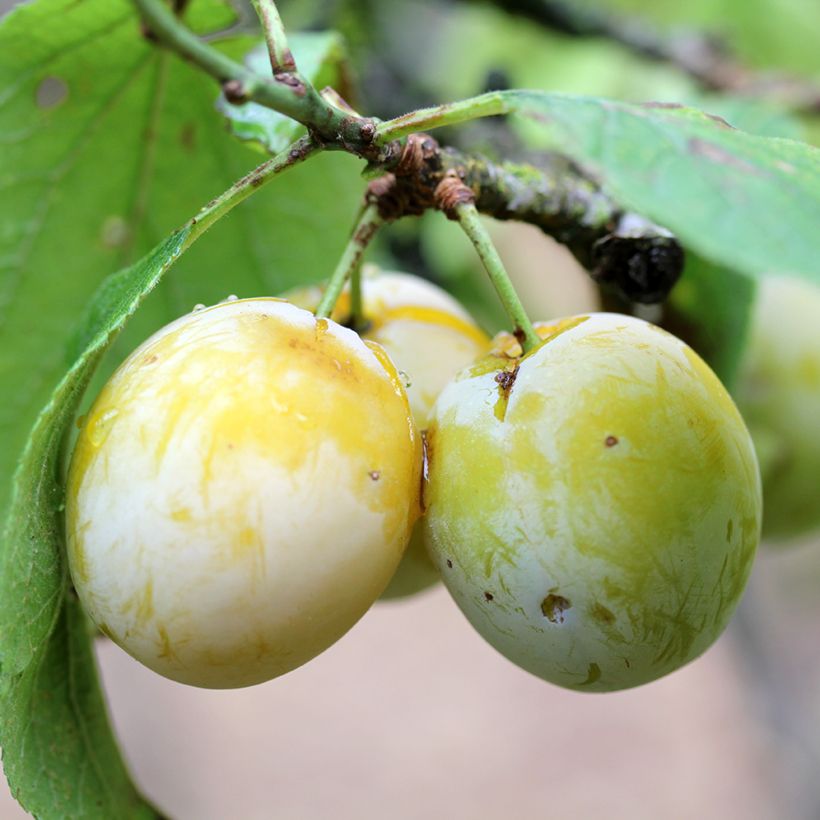

Plant habit
Fruit
Flowering
Foliage
Botanical data
Prunus
domestica
Quetsche Blanche de Létricourt
Rosaceae
European plum, Common plum, Garden plum
Cultivar or hybrid
Other Plum Trees
View all →Planting and care
The perfectly hardy Blanche Létricourt Plum Tree can withstand temperatures as low as -15°C and can be grown up to an altitude of 1000m (3281ft). When grown in optimal conditions, it is one of the easiest fruit trees to cultivate, generous and robust. Plum trees bloom early in spring and are therefore exposed to frost, although frost rarely compromises plum harvests. Avoid areas that are too exposed to northerly and easterly winds in the coldest regions. The plum tree will produce beautiful fruits when grown in warm and sunny locations sheltered from strong winds (the branches are very brittle). It is a vigorous tree that is suitable for all types of soil, although it prefers rich, moist, deep, and well-drained, slightly acidic soil, without stagnant moisture or excessive limestone. It only truly dislikes waterlogged soil. The plum tree is cultivated only in free forms, called open centre. Its white blossom brings a fresh touch to a natural garden or orchard in spring.
The plum tree should be planted from November to March, during its vegetative rest period, excluding freezing periods. Container-grown trees can be planted year-round as long as the soil is neither frozen nor waterlogged. Prune and heel in bare-root plants if you cannot plant immediately. In open ground, you can plant plum trees in groups of 3 or 5, spacing the trees 6 to 7m (20 to 23ft) apart.
Prepare the soil well. Dig a wide planting hole at least 3 times the size of the root ball (80x80cm (32in)). Ensure good drainage with some gravel. Place the tree in the hole and install a stake without tying it too tightly. Fill in by tamping down the garden soil enriched with compost, matured manure, and 2 or 3 handfuls of crushed horn, without burying the graft collar (leave the graft point 10cm (4in) above the ground). Form a dip around the base and water abundantly and regularly to help your plum tree establish itself.
Water regularly in the three years following planting as the soil must remain moist throughout the summer. It does not like excessively dry soil. If there is a lack of water, its fruits may fall prematurely. After 2 or 3 years, it will withstand short periods of drought better. Mulch the base of your plum tree during the first few years with dry vegetation (bark, dead leaves, straw, etc.) to keep it moist in the summer.
If necessary, thin out the fruits. Ripe plums attract wasps: collect fallen fruits from the ground. If necessary, remove shoots that have grown at the base of the tree, but hoe carefully, as its roots are close to the surface. Apply manure or fertiliser for fruit trees in autumn or spring.
Planting period
Intended location
Care
Planting & care advice
This item has not been reviewed yet - be the first to leave a review about it.
Similar products
Haven't found what you were looking for?
Hardiness is the lowest winter temperature a plant can endure without suffering serious damage or even dying. However, hardiness is affected by location (a sheltered area, such as a patio), protection (winter cover) and soil type (hardiness is improved by well-drained soil).

Photo Sharing Terms & Conditions
In order to encourage gardeners to interact and share their experiences, Promesse de fleurs offers various media enabling content to be uploaded onto its Site - in particular via the ‘Photo sharing’ module.
The User agrees to refrain from:
- Posting any content that is illegal, prejudicial, insulting, racist, inciteful to hatred, revisionist, contrary to public decency, that infringes on privacy or on the privacy rights of third parties, in particular the publicity rights of persons and goods, intellectual property rights, or the right to privacy.
- Submitting content on behalf of a third party;
- Impersonate the identity of a third party and/or publish any personal information about a third party;
In general, the User undertakes to refrain from any unethical behaviour.
All Content (in particular text, comments, files, images, photos, videos, creative works, etc.), which may be subject to property or intellectual property rights, image or other private rights, shall remain the property of the User, subject to the limited rights granted by the terms of the licence granted by Promesse de fleurs as stated below. Users are at liberty to publish or not to publish such Content on the Site, notably via the ‘Photo Sharing’ facility, and accept that this Content shall be made public and freely accessible, notably on the Internet.
Users further acknowledge, undertake to have ,and guarantee that they hold all necessary rights and permissions to publish such material on the Site, in particular with regard to the legislation in force pertaining to any privacy, property, intellectual property, image, or contractual rights, or rights of any other nature. By publishing such Content on the Site, Users acknowledge accepting full liability as publishers of the Content within the meaning of the law, and grant Promesse de fleurs, free of charge, an inclusive, worldwide licence for the said Content for the entire duration of its publication, including all reproduction, representation, up/downloading, displaying, performing, transmission, and storage rights.
Users also grant permission for their name to be linked to the Content and accept that this link may not always be made available.
By engaging in posting material, Users consent to their Content becoming automatically accessible on the Internet, in particular on other sites and/or blogs and/or web pages of the Promesse de fleurs site, including in particular social pages and the Promesse de fleurs catalogue.
Users may secure the removal of entrusted content free of charge by issuing a simple request via our contact form.
The flowering period indicated on our website applies to countries and regions located in USDA zone 8 (France, the United Kingdom, Ireland, the Netherlands, etc.)
It will vary according to where you live:
- In zones 9 to 10 (Italy, Spain, Greece, etc.), flowering will occur about 2 to 4 weeks earlier.
- In zones 6 to 7 (Germany, Poland, Slovenia, and lower mountainous regions), flowering will be delayed by 2 to 3 weeks.
- In zone 5 (Central Europe, Scandinavia), blooming will be delayed by 3 to 5 weeks.
In temperate climates, pruning of spring-flowering shrubs (forsythia, spireas, etc.) should be done just after flowering.
Pruning of summer-flowering shrubs (Indian Lilac, Perovskia, etc.) can be done in winter or spring.
In cold regions as well as with frost-sensitive plants, avoid pruning too early when severe frosts may still occur.
The planting period indicated on our website applies to countries and regions located in USDA zone 8 (France, United Kingdom, Ireland, Netherlands).
It will vary according to where you live:
- In Mediterranean zones (Marseille, Madrid, Milan, etc.), autumn and winter are the best planting periods.
- In continental zones (Strasbourg, Munich, Vienna, etc.), delay planting by 2 to 3 weeks in spring and bring it forward by 2 to 4 weeks in autumn.
- In mountainous regions (the Alps, Pyrenees, Carpathians, etc.), it is best to plant in late spring (May-June) or late summer (August-September).
The harvesting period indicated on our website applies to countries and regions in USDA zone 8 (France, England, Ireland, the Netherlands).
In colder areas (Scandinavia, Poland, Austria...) fruit and vegetable harvests are likely to be delayed by 3-4 weeks.
In warmer areas (Italy, Spain, Greece, etc.), harvesting will probably take place earlier, depending on weather conditions.
The sowing periods indicated on our website apply to countries and regions within USDA Zone 8 (France, UK, Ireland, Netherlands).
In colder areas (Scandinavia, Poland, Austria...), delay any outdoor sowing by 3-4 weeks, or sow under glass.
In warmer climes (Italy, Spain, Greece, etc.), bring outdoor sowing forward by a few weeks.



































